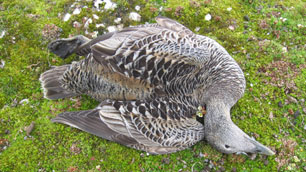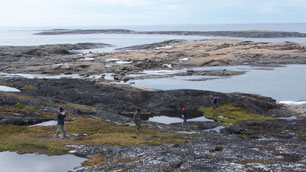Avian Cholera May Spread in Arctic: Scientists
 Avian cholera could spread into areas of the Arctic, including parts of Canada and Greenland, where the disease has not been present before, scientists say.
Avian cholera could spread into areas of the Arctic, including parts of Canada and Greenland, where the disease has not been present before, scientists say.
The potent bacterial disease is naturally occurring and highly contagious in birds, but not to humans.
Avian cholera has usually been found in more southern parts of North America, but it has killed thousands of common eider ducks and other birds in Canada’s eastern Arctic since 2004.
“We’re perplexed [with] how it spreads and how it is persisting,” Grant Gilchrist, a research scientist with Environment Canada, told CBC News.
Common eider duck colonies along the southern coast of Baffin Island, in Foxe Basin and in Ungava Bay have been devastated by avian cholera.
In the summer of 2006, Gilchrist found more than 3,000 common eider ducks dead from the infection on Nunavut’s Southampton Island.
Gilchrist said avian cholera has also infected populations of Canada geese, snow geese, king eider ducks and snow buntings, but the effects on those species have not been as severe as with common eider ducks.
Risk of spreading to Greenland
Gilchrist said the number of common eider duck deaths has been dropping lately, but he warned that outbreaks can reoccur.
 “It may disappear entirely for a while and then, in the future for unknown reasons, it rears its ugly head again,” he said.
“It may disappear entirely for a while and then, in the future for unknown reasons, it rears its ugly head again,” he said.
Gilchrist said Environment Canada is concerned that avian cholera may spread into Cumberland Sound or Frobisher Bay, where the disease has not been detected before.
As well, he said, scientists are worried avian cholera may jump across Davis Strait from Canada to Greenland.
“This is a very, very contagious disease, and so there’s a strong risk that eiders that carry the disease that might be originating from Canada could overwinter in the same places in the west coast of Greenland,” Gilchrist said.
“The disease has the potential, we think, to jump into the breeding population of Greenland as well.”
Flemming Merkel, a researcher with the National Environmental Research Institute in Denmark, said he is working with people in Greenland to keep an eye on bird colonies there.
“There’s a large exchange of birds between Canada and Greenland, and a large part of the Canadian breeding birds come to Greenland in the winter. So throughout the winter, they are more or less in the same area,” Merkel said.
Inuit communities in both Canada and Greenland are taking part in avian cholera monitoring programs.
Merkel said scientists are trying to better understand how avian cholera is transmitted, in the hopes of preventing its spread.



